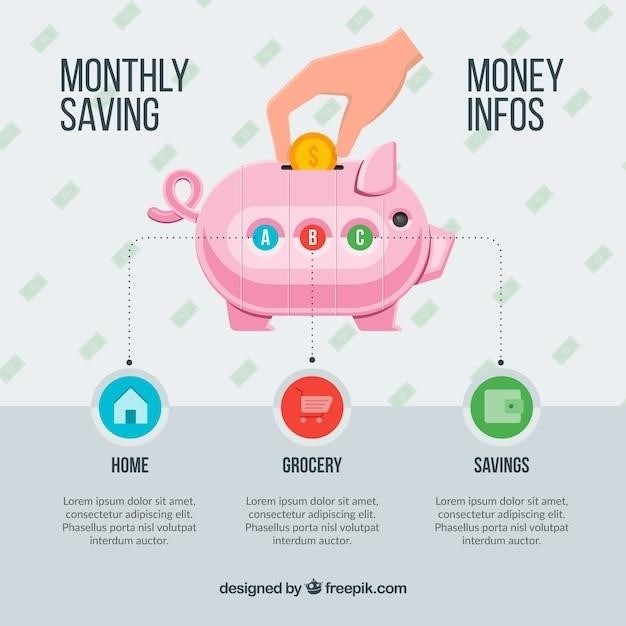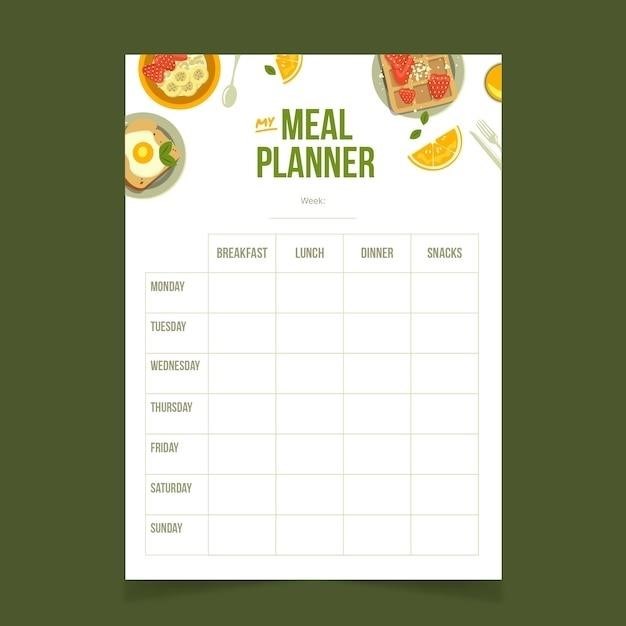
How to Budget Money on a Low Income
This article provides a comprehensive guide to budgeting on a low income, covering topics like setting financial goals, tracking income and expenses, identifying areas to cut costs, utilizing resources for low-income individuals, building an emergency fund, and adjusting your budget over time; It also explores the importance of differentiating needs from wants and the role of a positive mindset in achieving financial stability.
Understanding the Importance of Budgeting
Budgeting is a crucial skill, especially when living on a low income. It allows you to take control of your finances, prioritize your needs, and make informed decisions about your spending. A budget acts as a roadmap, helping you allocate your limited income effectively and avoid unnecessary expenses. This is particularly important for low-income earners, who often face greater financial challenges and have less room for error.
By creating a budget, you gain a clear understanding of your income and expenses. You can identify areas where you might be overspending and find opportunities to save money. This can help you reduce financial stress, build a sense of security, and work towards achieving your financial goals, whether it’s paying off debt, saving for a down payment on a house, or simply having a little extra cash at the end of the month.
More than just a tool for managing money, budgeting can also empower you to make conscious choices about your spending habits. It encourages you to differentiate between needs and wants and prioritize the things that truly matter to you. This shift in mindset can lead to a more fulfilling financial life, even on a limited income.
Setting Realistic Financial Goals
Setting financial goals is essential for staying motivated and focused on your budgeting journey. When you have specific targets in mind, it becomes easier to prioritize your spending and make choices that align with your long-term aspirations. However, it’s crucial to set goals that are both achievable and meaningful to you.
Start by identifying your short-term and long-term financial goals. Short-term goals could include saving for a vacation, paying off a small debt, or building an emergency fund. Long-term goals might involve buying a home, investing for retirement, or funding your child’s education. Once you have a clear picture of your goals, break them down into smaller, more manageable steps. This will make them feel less daunting and more attainable.
When setting your goals, it’s important to be realistic about your income and expenses. Don’t set unrealistic expectations that will only lead to frustration and discouragement. Instead, focus on making small, gradual improvements over time. Celebrate your successes along the way, no matter how small they may seem. This will help you stay motivated and on track to achieve your financial goals.
Tracking Your Income and Expenses
Before you can effectively budget, you need to understand where your money is coming from and where it’s going. This is where tracking your income and expenses comes in. By keeping a close eye on your financial inflows and outflows, you’ll gain valuable insights into your spending habits and identify areas where you can potentially cut back. This process can seem tedious at first, but it’s essential for developing a successful budget.
There are several methods you can use to track your income and expenses. You can keep a simple spreadsheet, utilize a budgeting app, or even use a notebook. The key is to choose a method that works best for you and that you’ll stick with consistently. Make sure to track all sources of income, including wages, benefits, and any other regular payments. Record all your expenses, big and small, including groceries, bills, transportation, entertainment, and even those small purchases you might overlook. The more detailed your tracking, the better understanding you’ll have of your spending patterns.
It’s also helpful to categorize your expenses. This will make it easier to analyze your spending and identify areas where you might be able to save money. Common expense categories include housing, food, transportation, utilities, healthcare, and entertainment. By tracking your income and expenses diligently, you’ll be well-equipped to make informed decisions about your budget and work towards achieving your financial goals.
3.1. Creating a Budget Worksheet
A budget worksheet is a powerful tool for organizing your income and expenses and visualizing your financial picture. It’s a simple yet effective way to track your money and make informed decisions about your spending. Creating a budget worksheet is a straightforward process that can be done using a spreadsheet program like Microsoft Excel or Google Sheets, or even a simple notebook. The worksheet should have distinct sections for your income and expenses.
In the income section, list all sources of income, including your wages, benefits, and any other regular payments. Be sure to include both your gross income (before taxes and deductions) and your net income (after taxes and deductions). This distinction is crucial for understanding how much money you actually have available to spend each month. In the expenses section, list all your monthly expenses, categorized for clarity. Categorize your expenses by essential needs such as housing, utilities, groceries, and transportation, and discretionary expenses such as entertainment, dining out, and subscriptions.
Once you’ve listed your income and expenses, you can calculate your net income and see how much money you have left over at the end of the month. This will give you a clear picture of your financial situation and help you identify areas where you can potentially cut back. Remember, a budget worksheet is a living document. As your income and expenses change, you’ll need to adjust your worksheet accordingly. Regularly reviewing and updating your budget worksheet will help you stay on track and achieve your financial goals.
3.2. Categorizing Expenses
Categorizing your expenses is essential for effective budgeting, as it helps you understand where your money is going and allows you to identify areas where you can potentially cut back. By grouping similar expenses together, you gain a clearer picture of your spending patterns and can make more informed decisions about how to allocate your resources. There are various ways to categorize expenses, but a common approach is to divide them into essential needs, discretionary wants, and debt payments.

Essential needs include expenses that are necessary for survival and well-being, such as housing, utilities, groceries, transportation, and healthcare. Discretionary wants encompass expenses that are not essential for survival but contribute to quality of life, such as entertainment, dining out, travel, and hobbies. Debt payments include any regular payments you make towards loans, credit cards, or other outstanding debts. Categorizing your expenses helps you prioritize your spending and ensure that your essential needs are met before indulging in discretionary wants. It also allows you to see where your money is going and identify any areas where you might be overspending.
By carefully categorizing your expenses, you can create a more effective budget that aligns with your financial goals and helps you manage your money wisely. Remember to regularly review and update your expense categories as your financial situation changes or your priorities shift. This ongoing process will ensure that your budget remains relevant and effective in helping you achieve financial stability.

Identifying Areas to Cut Expenses
Once you have a clear understanding of your income and expenses, the next step is to identify areas where you can cut back. This may require some creative thinking and a willingness to adjust your lifestyle, but it can significantly impact your financial well-being. Start by reviewing your expense categories and looking for areas where you may be overspending or where you can find alternatives. Consider your subscriptions, entertainment expenses, dining out habits, and transportation costs. Are there any services you can cancel or reduce? Can you find cheaper alternatives for your entertainment or dining needs? Can you explore carpooling or public transportation to save on fuel costs?
It is important to differentiate between needs and wants. While cutting back on wants can help you save money, it is essential to ensure that your essential needs are still met. If you are struggling to make ends meet, consider reaching out to local community resources or government assistance programs for help with basic necessities like food, housing, or healthcare. Remember that saving money does not always mean sacrificing everything you enjoy. There are often creative ways to find affordable alternatives or reduce your spending without compromising your quality of life.
By taking the time to identify areas where you can cut expenses, you can create a more sustainable budget that helps you manage your money effectively and build a stronger financial foundation.
4.1. Differentiating Needs from Wants
When identifying areas to cut expenses, it is crucial to distinguish between needs and wants. Needs are essential items or services that are required for survival and well-being, such as food, shelter, healthcare, and utilities. Wants, on the other hand, are non-essential items or services that provide comfort, enjoyment, or convenience but are not strictly necessary for survival. While cutting back on wants can help you save money, it is essential to prioritize your needs and ensure they are met.
For example, consider your housing situation. While renting a luxurious apartment may be desirable, it is not a necessity. You can explore more affordable housing options, such as sharing an apartment with roommates or renting a smaller apartment. Similarly, while eating out frequently can be enjoyable, it is not a necessity. You can cook more meals at home, which can significantly reduce your food expenses. By focusing on your needs and finding creative ways to satisfy your wants without overspending, you can create a more sustainable budget that allows you to prioritize your financial well-being.
Remember, the goal is not to deprive yourself but to make informed choices about your spending and ensure that your essential needs are met while leaving room for some of the things you enjoy.
4;2. Exploring Cost-Saving Strategies
Once you have differentiated between your needs and wants, you can start exploring cost-saving strategies for each category. There are numerous ways to reduce expenses without compromising your quality of life. For instance, in the realm of food, you can take advantage of grocery store sales and discounts, plan your meals ahead of time to avoid impulse purchases, and consider growing your own produce if possible. When it comes to transportation, you can opt for public transportation, carpooling, or cycling instead of driving your own car, which can significantly reduce fuel costs and vehicle maintenance expenses.
Another effective cost-saving strategy is to negotiate your bills. This could include your phone, internet, or cable bills. Contact your service providers and inquire about lower rates or discounts. You can also consider switching providers if you find a better deal. Additionally, cutting back on non-essential subscriptions, such as streaming services or memberships, can free up a considerable amount of money each month.
Remember, every dollar saved contributes to your overall financial well-being. By diligently seeking out cost-saving opportunities in various areas of your spending, you can create a more sustainable budget and achieve your financial goals.
Utilizing Resources for Low-Income Individuals
Many resources are available to help low-income individuals manage their finances and improve their financial well-being. These resources can provide financial assistance, education, and support, making it easier to stretch your budget and achieve financial stability. One key source of support is government assistance programs. These programs offer financial aid for various needs, such as food, housing, healthcare, and childcare. Depending on your eligibility, you may be able to access programs like SNAP (Supplemental Nutrition Assistance Program), TANF (Temporary Assistance for Needy Families), Medicaid, and WIC (Special Supplemental Nutrition Program for Women, Infants, and Children).
Beyond government assistance, there are numerous community resources and support networks available to low-income individuals. Local food banks, shelters, and community centers can provide access to essential necessities like food, clothing, and shelter. You can also find valuable financial literacy programs and workshops offered by community organizations and non-profits. These programs can equip you with the knowledge and skills to create a budget, manage debt, and make informed financial decisions.
By utilizing these resources, you can access support and guidance that can significantly ease the financial burden of living on a low income. Don’t hesitate to reach out to these organizations for assistance, as they are dedicated to helping individuals in need achieve financial stability and security.
5.1. Government Assistance Programs
Government assistance programs are a valuable resource for low-income individuals, offering financial support for various needs. These programs can provide a lifeline, helping to alleviate financial pressure and improve quality of life. One such program is SNAP (Supplemental Nutrition Assistance Program), which provides food assistance to eligible low-income households. TANF (Temporary Assistance for Needy Families) provides financial assistance to families with children in need, offering support for basic necessities like food, clothing, and shelter. Medicaid, a government-funded health insurance program, provides affordable healthcare coverage to low-income individuals and families.
For pregnant women, breastfeeding mothers, and children under five years old, the WIC (Special Supplemental Nutrition Program for Women, Infants, and Children) program provides supplemental food assistance, nutrition education, and breastfeeding support. The Emergency Food Assistance Program (TEFAP) offers food assistance to low-income people, providing a vital safety net during times of need.
By researching and applying for eligible government assistance programs, individuals can access crucial financial support that can make a significant difference in their lives. These programs aim to provide a helping hand, ensuring basic needs are met and creating opportunities for a brighter future.


